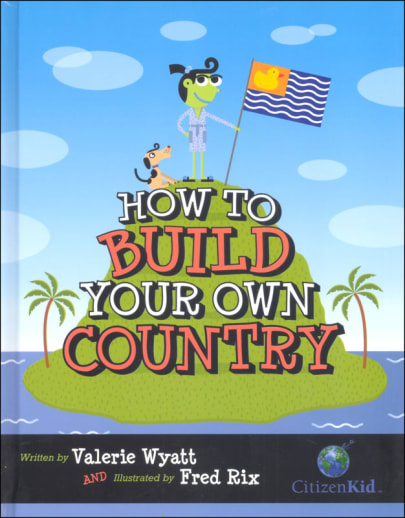This may be the most original way I have seen to learn about social studies! Follow the clearly defined instructions and POOF! Inspiration can come from anywhere – your interests, a pet, something in your room, a color, etc. There is a tongue-in-cheek element here, clearly this is an imaginative endeavor, but it gets kids thinking. Artistic students will enjoy creating a flag, musical kids will enjoy coming up with a national anthem, social kids will like the part of meeting neighboring countries! When it comes to writing up a constitution, the student will have to make some moral judgements about what they feel is important to include. It's quite an exercise and would be fun to do with a group – and it can all be done with or without the internet. ~Sara
How to Build Your Own Country
SKU
051704
ISBN
9781554533107
Grade 3-7
These icons are designed to help you quickly understand and learn important information about our products.
Teaching Method
Traditional
Teacher-centered curriculum commonly used in classrooms that may include a text, teacher manual, tests, etc.
Charlotte Mason
A methodology based on the work of a 19th century educator who maintained that children learn best from literature (Living Books), not textbooks.
Classical
A methodology based on the Latin Trivium (three stages of learning), including the grammar stage (memorization and facts), logic stage (critical thinking), and rhetoric stage (developing/defending ideas).
Unit Study
A thematic or topical approach centered around one topic that integrates multiple subject areas.
Montessori (Discovery)
A methodology based on the work of a 20th century educator that emphasizes student and sensory-driven discovery learning and real-life applications.
Other
Other methodologies
Religious Content
Secular
Contains content contrary to common Christian beliefs (i.e. evolution).
Neutral
Avoids religious or theoretical topics or presents multiple viewpoints without preference.
Christian/Religious
Faith-based or including instructional religious content.
Learning Modality
Auditory
Learns through listening, talking out loud or reading out loud.
Visual
Learns through seeing, prefers written instructions and visual materials.
Kinesthetic/Tactile (Hands-On)
Learns through moving, doing and touching.
Multi-Sensory
Curriculum that employ a variety of activities/components.
Presentation
Sequential
Curriculum progresses through well-defined learning objectives. Emphasizes mastery before moving to the next topic.
Spiral
Topics and concepts are repeated from level to level, adding more depth at each pass and connecting with review.
Conceptual/Topical
Focus is on the “why,” often with a unifying concept as well as specific skills; coverage may be broader.
Teacher Involvement
Low Teacher Involvement
Student-led materials; parent acts as a facilitator.
Medium Teacher Involvement
A mix of teacher-led time and independent student work.
High Teacher Involvement
Teacher-led lessons; may utilize discussions, hands-on activities and working together.
Additional Materials Required
No other materials needed
Everything you need is included.
Other Materials Required
There are additional required resources that are a separate purchase.
Other Materials Optional
There are additional resources mentioned or recommended but are not absolutely necessary.
Consumable
Consumable
Designed to be written in; not reusable.
Non-Consumable
Not designed to be written in; reusable.
Our Price
$17.99 $17.99 $13.75
Rainbow Savings: $4.24
Description
Publisher's Description of How to Build Your Own Country
How to Build Your Own Country is an interactive and totally original learning experience that shows kids how to build their very own country from scratch. This book, the only one of its kind, offers children the expertise and advice they'll need to plant their flag in the backyard, in the bedroom or online. Kids will be amazed to discover that anyone can do it. Nation-building advice is peppered with examples of events that have shaped countries throughout history, teaching young readers about government, elections, geography and global issues. Backed up with lots of amazing examples of real micronations - some established or ruled by kids - How to Build Your Own Country promises to inspire, entertain and inform young nation-builders.Want to build your very own country from scratch? It's easy:Step 1: Stake Out Your Identity ... with a flag, money and a national anthem. Learn how to put your country's name on the map.Step 2: Run the Country ... with a government, constitution, laws and an economy. Step 3: Meet the Neighbors ... and join other nations on the big issues that face the whole world, such as poverty, global warming, security and international aid. How To Build Your Own Country is part of CitizenKid: A collection of books that inform children about the world and inspire them to be better global citizens.
Details
| Product Format: | Hardcover |
|---|---|
| Grades: | 3-7 |
| Brand: | Kids Can Press |
| Author: | Valerie Wyatt |
| ISBN: | 9781554533107 |
| Length in Inches: | 9.25 |
| Width in Inches: | 7.25 |
| Height in Inches: | 0.375 |
| Weight in Pounds: | 0.656 |
Videos
Reviews

